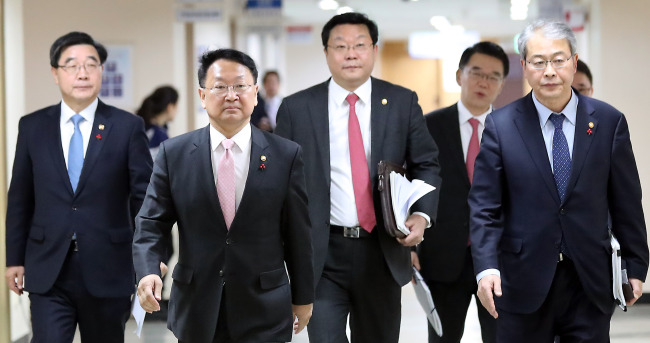The South Korean government Thursday slashed its growth forecast for the economy next year to 2.6 percent, citing worsening employment conditions and contraction in domestic consumption.
It was a 0.4 percentage point cut from a previous 3 percent forecast made in June, but still higher than recent projections by private economic institutions.
The projection marks the third consecutive year of low growth, following 2.6 percent growth in 2015 and 2016.
“We are seeing signs of slowing domestic consumption along with weakening employment indicators, as local industries are losing competitiveness,” said Choi Sang-mok, first vice minister for strategy and finance at a press briefing.
Along with the revised growth forecast, the government released its 2017 policy plan, vowing to maximize fiscal spending in the first quarter of next year and add new jobs in the public sector, focusing on containing macroeconomic risks and stabilizing living conditions of the general public.
More than 20 trillion won ($16.5 billion) worth of fiscal measures will be implemented to bolster growth next year, including about 13 trillion won of government expenditure and 7 trillion won of support from public financial institutions.
The government will raise its annual spending by 1 percentage point, or 3 trillion won, to add to fiscal spending. The Finance Ministry also decided to front-load 31 percent of the government’s annual budget in the first quarter of next year, spending as much as possible in a bid to stimulate the economy in the shortest span of time.
 |
Finance Minister Yoo Il-ho (second from left) and other officials walk together on the way to a joint press conference held at the Seoul Government Complex on Thursday. (Yonhap) |
At a ministerial meeting on economic affairs Thursday, acting President Hwang Kyo-an emphasized the role of fiscal policies.
“When the economy is in a slow phase, fiscal policies should be strong enough to bolster it,” Hwang said. “From early next year, the government will mobilize all available fiscal sources.”
Private institutions have been more pessimistic about next year’s economy, with the LG Economic Research Institute forecasting 2.2 percent growth and Hyundai Research Institute 2.3 percent, citing political factors as the biggest risk to the economy.
“The government’s projection reflects the effects of all the policy measures planned for next year,” said Lee Ho-seung, director general of the economic policy bureau at the Finance Ministry.
The ministry’s 2.6 percent estimate is aligned with an earlier forecast by the Organization for Economic Cooperation and Development, the official said.
“At the moment, we are not taking into account concerns about the political situation or about the possibility of a new government,” Choi added.
But economic experts said growing political risks will become a significant factor to the economy and domestic demand in particular.
“The ongoing political scandal is making the people depressed and unwilling to spend,” said Ju Won, chief of macroeconomic research at Hyundai Research Institute. “Businesses would also halt making new investments amid the highly unpredictable situation.”
Referring to the government’s latest plans, Ju added, “Such an active fiscal plan is very much needed, but it won’t do much to buck the slowing trend. … As there is no monetary policy choice, expanding the role of fiscal policies is the only thing the government can do to defend the economy.”
The Bank of Korea said Thursday it will maintain an accommodative monetary policy next year, forecasting 2-percent-range growth.
“The Korean economy is expected to continue its modest growth amid high uncertainties,” the BOK said in a report on its monetary strategy for next year. “The slowing of private consumption and construction investment will become greater, despite a slight improvement in exports and facility improvement.”
Meanwhile, Finance Minister Yoo Il-ho also said during a briefing Thursday that on the global front, the expected US rate hikes and growing trade protectionism are factors that will weigh down on Korea’s growth next year.
“We should prepare for a situation in which global downside risks are coupled with our domestic weaknesses like massive household debt and insolvent companies.”
Restructuring in major industries will also cut jobs in the labor market -- another major concern for the government.
The Finance Ministry, in its plan, estimated the number of newly employed people would be around 260,000 in 2017, down from 290,000 this year.
The government said it will hire more than 60,000 new employees and state-run organizations will employ 20,000 new workers next year, with the aim of easing growing anxiety in the labor market.
Tax credits for businesses in the private sector will also be expanded, on top of the current 3 to 5 percent tax deductions on new investments if they add new full-time jobs.
The government budget for job creation next year is 17.1 trillion won, up from 15.8 trillion won this year.
As for the country’s longer-term growth, the government will launch a new control tower that will discuss and formulate policies preparing for the fourth industrial revolution.
“The control tower will set the direction for the development of core technologies in artificial intelligence, the Internet of Things, cloud computing and big data, and discuss improving regulations for the new industries,” the ministry said.
By Song Su-hyun (
song@heraldcorp.com)







![[Today’s K-pop] Blackpink’s Jennie, Lisa invited to Coachella as solo acts](http://res.heraldm.com/phpwas/restmb_idxmake.php?idx=644&simg=/content/image/2024/11/21/20241121050099_0.jpg)
